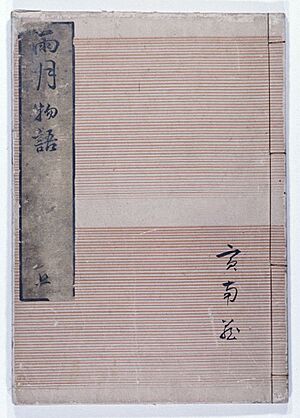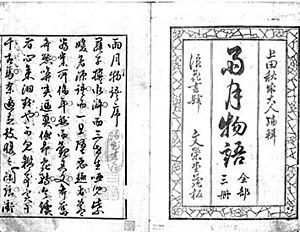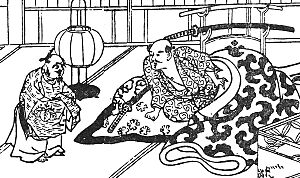Ugetsu Monogatari facts for kids
Tales of Moonlight and Rain (Ugetsu Monogatari (雨月物語)) is a collection of nine supernatural stories. It was first published in 1776. This book is the most famous work by the Japanese writer Ueda Akinari.
The stories are mostly based on old Japanese and Chinese ghost stories. This collection is very important for understanding literature from the Edo period (1603–1867) and kaidan (ghost story) writings. It is also seen as an early example of the yomihon style of books. The famous film Ugetsu (1953) by Kenji Mizoguchi was based on two stories from this collection. This film helped make Japanese movies popular in Western countries.
Contents
What the Title Means
The word Ugetsu is made of two parts. u (雨) means "rain," and getsu (月) means "moon." The title comes from a line in the book's introduction that talks about "a night with a misty moon after the rains."
Rain and moon are common symbols in East Asian stories. They often suggest something supernatural or mysterious is about to happen. The word monogatari (物語) in the title means "story" or "series." This connects the book to other important Japanese and Chinese works, like The Tale of Genji (Genji monogatari).
The most common English name for the book is Tales of Moonlight and Rain. Other names include Tales of a Clouded Moon.
When it Was Published
Ugetsu Monogatari was first printed in 1776 using woodblock printing. The book has nine stories spread across five volumes:
- Volume 1: Shiramine and Kikka no chigiri
- Volume 2: Asaji ga Yado and Muo no Rigyo
- Volume 3: Bupposo and Kibitsu no Kama
- Volume 4: Jasei no In
- Volume 5: Aozukin and Hinpiku-ron
Ueda Akinari used a pen name, Senshi Kijin (剪枝畸人), when he published the book. This name means "cut finger" or "eccentric." Ueda had a disability from smallpox as a child, which affected his fingers. Even though he used a pen name, it is now clear that Ueda Akinari wrote this book.
Ugetsu Monogatari is seen as an early example of the yomihon style of books from the Edo period. It is still popular today and inspires new works.
How Other Stories Influenced It
Adapted Stories
Ugetsu Monogatari is a hon'an shosetsu (adapted novel). This means Ueda took stories from other places and changed them to fit Japanese culture and history. He used stories from Chinese collections like Chien Teng Hsin Hua. Back then, changing existing stories was not seen as copying. Instead, writers were praised for putting their own spin on old tales.
Ueda changed the stories to be set in Japan. He added details about Japanese history, people, and folklore. He was a scholar of kokugaku, which focused on Japanese traditions. This led him to remove many signs of the stories' Chinese origins.
Borrowed Ideas
Ueda borrowed many ideas, images, and writing styles from other famous books. More than 60 parts of Ugetsu Monogatari come from Chinese literature. Over 100 parts come from Japanese literature. He borrowed so much from The Tale of Genji that some sentences in his book seem to be taken directly from it.
Noh Theater
The book also shows a lot of influence from Noh theater. Noh is a traditional Japanese musical drama. In each story, the characters often fit the roles of lead and supporting actors from Noh plays. The stories also follow the jo-ha-kyū dramatic structure, which is famous in Noh.
Kaidan (Ghost Stories)
Ugetsu Monogatari is one of the most famous kaidan-shu, which are collections of supernatural or ghost stories. These stories became very popular in Japan during the Edo period. The book uses elements from different types of kaidan, including adapted Chinese stories, Buddhist ghost stories, and Japanese folk tales.
During the Edo period, Japan was peaceful. Ghost stories became more about entertainment than just religious lessons. Ueda continued this trend. He removed some religious parts from stories like Asaji ga Yado. He even joked in his introduction that his stories were not meant to be believed, so he wouldn't get into trouble like some other writers.
The Stories
White Peak (Shiramine)
In Shiramine, a monk meets the ghost of Emperor Sutoku at a shrine. The emperor is angry at his family who removed him from power. The monk criticizes the emperor for being influenced by foreign ideas. The emperor gets very angry and turns into a giant tengu bird, then flies away. The story ends by listing historical events that people believed were caused by the emperor's angry spirit after he died.
This story is heavily influenced by Noh theater. It is based on the play Matsuyama Tengu.
The Chrysanthemum Pledge (Kikka no Chigiri)
In Kikka no Chigiri, a warrior gets sick and is helped by a kind man. They become good friends. The warrior promises to return on the day of the Chrysanthemum Festival. When he goes home, he finds his lord has been killed. His cousin holds him prisoner, so he cannot keep his promise. To keep his word, he takes his own life and returns as a ghost to his friend. Afterward, his friend visits the cousin and kills him for his disloyalty.
This story was adapted from a Chinese tale called Fan Chu-ch'ing Chi-shu Ssu-sheng-chiao.
The House in the Reeds (Asagi ga Yado)
Asagi ga Yado is set in 1452. It tells of a man who leaves his wife to make money selling silk. A war breaks out, and everyone in his village flees, but his wife stays to wait for him. She faces danger and hunger alone. The husband is robbed and gets sick, so he cannot return. Seven years later, he goes back to his village. He finds his house in good condition and his wife waiting, looking older. They have a happy reunion and fall asleep. The next morning, he wakes to find the house in ruins and only his wife's grave. He realizes he had seen her ghost.
This story is an adaptation of The Tale of Ai-Ching from a 14th-century Chinese collection. It is one of the two stories that inspired the film Ugetsu.
The Carp That Appeared in My Dream (Muo no Rigyo)
In Muo no Rigyo, a monk loves painting fish and often saves them from fishermen. One day, he dreams he is playing with fish in a river. When he wakes, he paints the fish from his dream. Later, he gets sick. While unconscious, the sea god grants his wish to be reborn as a carp, because he saved so many fish. But then, one of his friends catches and eats him. The monk returns to his human body and confronts his friend.
Bird of Paradise (Bupposo)
In Bupposo, a man and his son are camping on Mount Kōya. They meet the ghosts of Toyotomi Hidetsugu and his court. The man enjoys talking with the ghosts about poetry and history.
Like Shiramine, this story focuses on poetry and discussions about history and literature.
The Cauldron of Kibitsu (Kibitsu no Kama)
In Kibitsu no Kama, a man leaves his loyal wife for another woman. His wife's angry spirit kills the other woman. Then the wife dies, but her ghost continues to chase her husband. The story describes his attempts to fight off his wife's ghost.
This story is based on the Chinese tale Mu-tan Teng-chi.
The Blue Hood (Aozukin)
In Aozukin, a traveling Buddhist priest visits a village. He learns that the local priest has become a demon after going crazy from losing his young lover. The demon is scaring the village. The traveling priest confronts the demon and places a blue hood on its head to save it through religious help.
This story is similar to a Buddhist setsuwa tale.
Theory of Wealth and Poverty (Hinpuku-ron)
In Hinpuku-ron, a samurai who loves money but has a good sense of humor rewards a servant who has been saving money. That night, the spirit of his gold visits him. They talk about money and if it is good or bad.
This story is set around 1595. It was inspired by a real samurai who was known for loving money, even though the samurai code (bushido) usually did not value wealth. The story suggests that money itself is neutral. Its effect depends on the person who has it. This idea was different from the common belief at the time that wealth was a reward for good behavior.
English Translations
The first English translation was published in 1938 and 1941. Other English translations have been published by Dale Saunders (1966), Kenji Hamada (1972), Leon Zolbrod (1974), and Anthony H. Chambers (2006).
Other Works Based on This Book
- Ugetsu: A 1953 film based on Asaji ga Yado and Jasei no In. It won an award at the Venice Film Festival.
- Jasei no In: A 1921 film directed by Thomas Kurihara.
- Takarazuka Revue Ugetsu Monogatari: A 1926 play by Harumichi Ono.
- Jasei no In: A 1960 film by Morihei Magatani.
- Ugetsu: A 2006 novel by Shinji Aoyama.
- Ugetsu Monogatari: A 2009 novel by Shimako Iwai.
See also
- Yomihon
- Monogatari
- Kokugaku
- Takizawa Bakin
- Asai Ryōi
- The Tale of Genji
- The Tales of Ise
- Nihon Ryōiki
- Konjaku Monogatarishū




